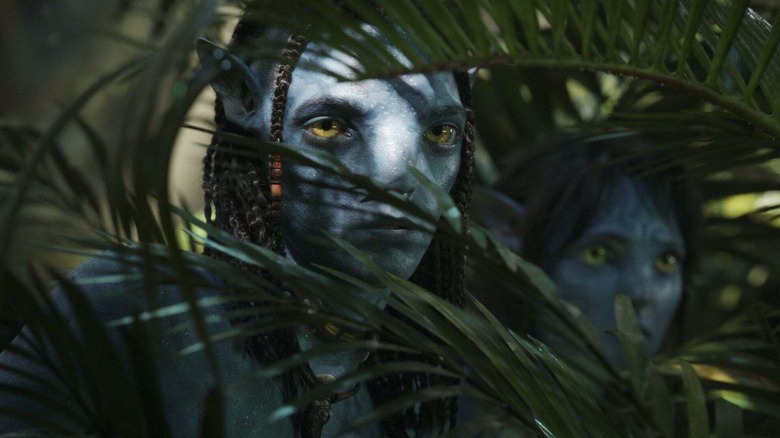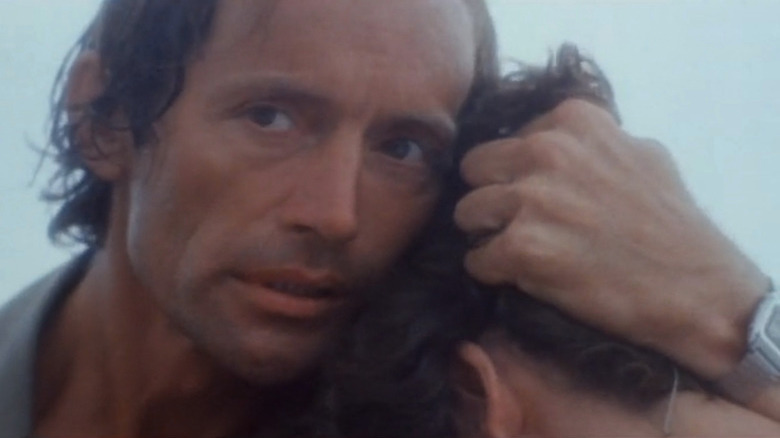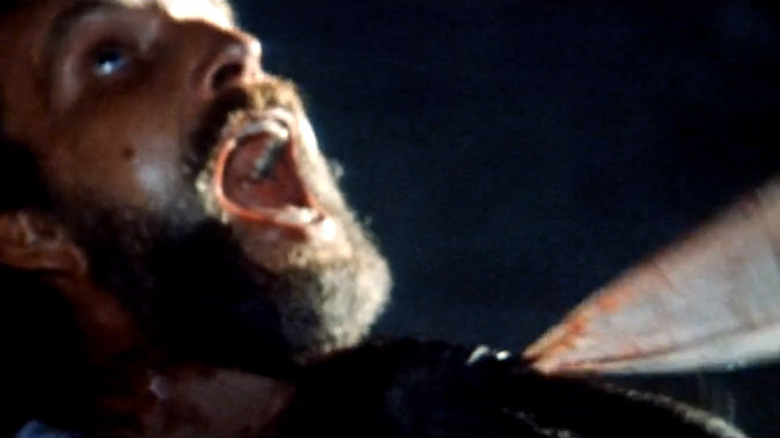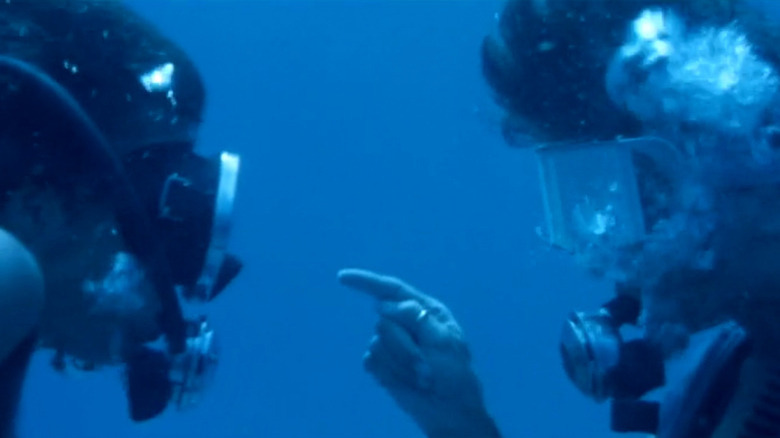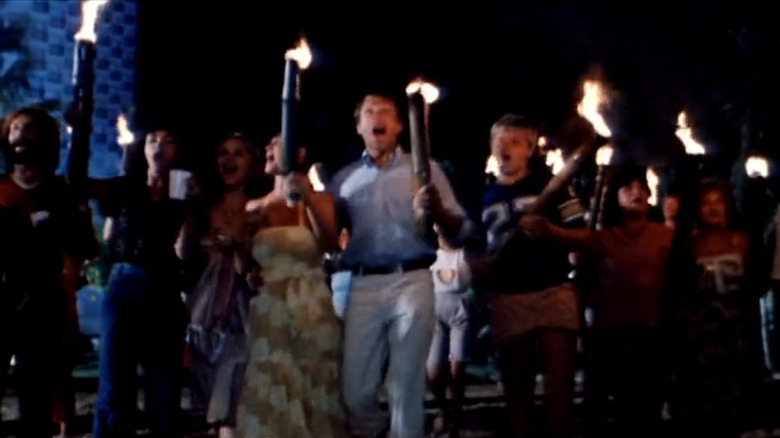The Seeds Of Avatar: The Way Of Water Were Planted In James Cameron's First Film
There's an expression you may have heard about "Avatar: The Way of Water," and that expression is this: "Never bet against James Cameron."
After all, James Cameron has directed one gigantic hit film after another, ever since his modestly budgeted breakout "The Terminator" got him gigs directing the action-packed monster movie "Aliens," followed by the ambitious undersea epic "The Abyss," the groundbreaking "Terminator II," the blockbuster action comedy "True Lies," and hey, did you ever hear about "Titanic" and "Avatar?" They made quite a bit of money. Just thought you should know, in case you somehow missed that.
Although fans might be eager to paint Cameron as an infallible hit machine, his directing career actually started with a critically lambasted dud: "Piranha II: The Spawning," a 1982 sequel to Joe Dante's 1978 horror comedy "Piranha," which was itself an unapologetic rip-off of "Jaws." It was an inauspicious debut for the future Oscar-winning filmmaker, made only more so by the fact that he was fired several weeks into shooting.
So if you were to bet against him in 1982, you'd have been right on the money, though it all worked out in the end. "Piranha II" might not have been a hit, but it planted creative and thematic seeds that would grow all throughout James Cameron's filmography, and sprout in "Avatar: The Way of Water."
Water we talking about?
Seriously, if you watch "Piranha II: The Spawning" today, you'll find it full of ideas, sequences and plot points that wound up evolving into "Avatar: The Way of Water." (We don't necessarily recommend watching "Piranha II," we're just saying that if you did it would be a treasure trove).
The film stars future "Terminator" and "Aliens" co-star Lance Henriksen as the sheriff of a small beach town where genetically mutated fish have begun eating everyone in sight. These new piranha can not only live in the ocean (where there are, usually, no piranha) but they can also breathe on land. And, just for funsies, they can frickin' fly. It's up to Henriksen to team up with his estranged wife, played by Tricia O'Neal, and their teenage son Chris, played by Ricky G. Paull, to save the day.
It may not sound a heck of a lot like "Avatar: The Way of Water" on the surface, except for the flying fish of course, and that's probably a big part of why people aren't swarming to rewatch this cult film en masse right now. But the general themes of the film would repeat throughout Cameron's career.
Something's fishy here
"Piranha II" emphasizes a strained family unit who grow together through shared strife, just like in "Aliens," "Terminator 2," and "The Way of Water." What's more, they stand in opposition to the threat of the military, who in both Cameron's first and most recent films wind up threatening everybody through the irresponsible pursuit of fishy goals.
In "Piranha II" it's genetic engineering to create super soldiers via the genetic manipulation of fish, something the villains in "Avatar" do anyway, except via the genetic alteration of blue cat people. In both films the heroes also oppose harmful fishing practices, either by trying to stop fishermen using TNT in "Piranha II," or by using heavy artillery to kill super whales.
The very first scene in the very first James Cameron feature film is of two lovers going scuba diving in order to have underwater sex. While that's more lascivious than most other James Cameron movies, it presages his obsession with aquatic storytelling and deep sea diving, and would eventually lead to scenes in "The Way of Water" where Jake and Neytiri's children seek deeper connections under the waves, either romantically with their fellow Na'vi or, you know, with super whales (of which there are admittedly few in "Piranha II").
These are deep dives
Both "Piranha II" and "Avatar: The Way of Water" feature extended scenes of people teaching deep sea diving and using underwater sign language. Both films feature sequences where inexperienced divers are brought by more experienced divers to an isolated location where their lives threatened by man-eating fish. Both films feature climaxes that begin with teenagers running off to the middle of the ocean by themselves, directly into harm's way, where they have to be rescued by their parents. Both films have climaxes that take place on sunken ships. Both films have characters driven, at the end of the film, by blood revenge.
It's starting to add up, isn't it?
What's more, both films evoke a certain spiritualism about sea life. The centerpiece of "Piranha II: The Spawning" is actually the "spawning" part. It's a grunion run, where the little aquatic critters arrive on the shore for mating purposes. They're just like the sea creatures in "Avatar: The Way of Water," which return cyclically to the film's central village to share intimate connections with the populace.
Tricia O'Neal's character in "Piranha II" gives a speech about how remarkable it is that grunions always meet "the first full moon after the spring equinox," at which point someone asks her, "But how do the fish know?" They have no answer. Sea life is just pretty darned magical in James Cameron movies.
And then of course there's the time in "Piranha II" where Chris tells his mother he'd like to be her "spiritual advisor," which is played like a joke, but when "Avatar: The Way of Water" comes along the whole story leads to the parents' discovering that their children are operating on higher planes than they realized. That connection is most likely a coincidence, but it's a notable one.
Making waves
In both films the danger looms after unthinking visitors with selfish values arrive. In "The Way of Water" it's a group of space whalers, demanding the chemicals from inside whale brains. In "The Spawning" it's a group of tourists wielding torches and marching towards the poor grunions, ominously chanting "We want fish! We want fish!"
Neither film is particularly subtle about its environmentalist goals. Or at all, really. Subtlety has never been James Cameron's strong suit. He makes in your face movies about the stuff he loves, and the stuff he loves is all over "Piranha II: The Spawning." He just finally got to do it on the enormous scale he always wanted to in "Avatar: The Way of Water."
James Cameron got his start on the production of "Piranha II" as the film's visual effects artist, before graduating to director after the original filmmaker Miller Drake — who would go on to do visual effects work for Cameron in "The Abyss" and "Terminator 2" — left the project. The same Cameron who spent decades developing the visual effects to make the "Avatar" movies spent his spare time in his room making even more flying fish for "Piranha II." He's still kinda the same filmmaker. He just utilizes computers to make the fish.
It's that level of commitment that makes James Cameron's debut feature, in his own words, "the very best flying piranha movie ever made." Unless those flying carnivorous fish that the Sully family rides in "Avatar: The Way of Water" are some kind of space piranha, in which case, then it's probably that film instead.
